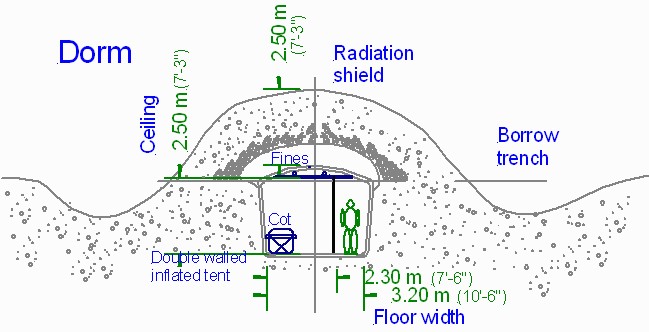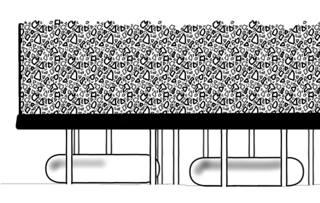Roof Support
One serious lunar problem will be your roof falling in on you.
Using the roof for radiation and heat shielding
The need for radiation shielding for lunar settlement occupants means that there will be significant mass on the roof of all buildings used for long term occupancy. Much of the electronic equipment will need shielding too. This shielding could be in the form of lunar regolith as suggested in Architecture as Mole Hills and Architecture as Tent City or material brought from Earth, but it must be provided.
Also, if your massive roof falls in on you, you will be in real trouble.
Inflatable Housing
Since the interior living space must be at considerably higher air pressure than the exterior, it is only logical to use the force this pressure exerts on the outside walls to help support the weight of the roof. The rooms then become like balloons getting much of their strength from their internal pressure. The amount of mass an inflated roof will support is directly related to the internal pressure.
A major problem comes when you lose the pressure and the massive roof falls in on you. Loss of pressure, or blow out, is a real possibility due to meteorites, ejecta, landing accidents, or industrial accidents. Even if you can get into an environmental suit, you will have to get to safety before your air supply runs out.
Pressure Considerations
One of the most important considerations in the design of a lunar settlement will be the internal air pressure.
High Pressure
High air pressure makes the living space more Earth like. People and plants accommodate easily and food is easy to cook.
But, spacesuits must be at low pressure for the joints to work with acceptable amounts of efforts. For the body to accommodate from normal air pressure to low spacesuit pressure can take as long as three hours.
Low Pressure
Low air pressure, with adequate oxygen content, allows accommodation to spacesuits in only a few minutes or just seconds in an emergency.
The long term health effects of low pressure are not fully known for people or plants. Any agricultural areas may need additional CO2 and nitrogen. The human body will simply never fully accommodate pressures below about 30 kPascal.
At low pressures you can use 100% oxygen which greatly simplifies the entire life support system. Testing this type of system is very dangerous and has resulted in two serious fires.
Water boils at such a low temperature that cooking is difficult. You simply cannot get things hot enough to really taste right.
Also low air pressure will not support as thick a layer of regolith over inflated buildings.
Supporting Regolith
Here are some of present ideas for lunar settlement air pressures and how much regolith they will support:
| Pressure | Pressure | Boiling Point | Regolith Shield | Regolith Supported | Comment |
|---|---|---|---|---|---|
| kPascal | PSI | C | Meters | Meters | |
| 101.3 | 14.2 | 100 | 5.4 | 32 | Earth standard, ISS body |
| 84 | 12.17 | ? | 4.5 | 27 | Denver, a high altitude city |
| 81.4 | 11.74 | ? | 4.3 | 26 | Mexico City, a high altitude city |
| 74.0 | 10.2 | 4.0 | 24 | Open airplane, ISS ports | |
| 59.1 | 8.3 | 19 | ISS spacesuit | ||
| 33.5 | 4.7 | 10 | Apollo spacesuit | ||
| 30.6 | 4.3 | 9.9 | Shuttle spacesuit | ||
| 26.0 | 3.65 | 69.0 | 1.4 | Top of Mount Everest | |
| 10.0 | 1.5 | .5 | 1/10 Atm, 16,000 m, unconscious in 10 sec |
The Regolith Shield column shows how much lunar regolith is needed to provide radiation shielding equivalent to the air above your head at these locations on Earth. The Regolith Support column shows how much lunar regolith can be supported on the Moon by that level of internal pressure.
These calculations are based on the following parameters:
| density of packed regolith | 1.9 | g/cm^3 | Used for this calculation |
| density of loose regolith | 1.5 | g/cm^3 | just poured in a pile |
| Lunar gravity | 1.63 | m/s^2 | about 1/6 Earth |
| Human body temperature | 37.0 | C | 98.6 F |
It is important to note that the internal pressure inside a living area has plenty of force to support a substantial thickness of lunar regolith above it for radiation and thermal shielding even if low pressures are used.
Safety rule
The roof cave in problem will require a strong safety rule that will greatly affect the design of lunar buildings. One possible rule is this:
- Roof Support Rule
- With the internal building pressure completely lost, a person wearing an environmental suit must have enough clearance to crawl to safety even if a second person is lying immobile in the evacuation path.
Rule's effects
Such a rule, combined with the very high cost of bringing mass from Earth, will make large open rooms very rare on the Moon. Rooms and even halls will require internal columns or bearing walls to hold up the roof with a loss of pressure. Most rooms will have to be narrow in at least one direction and will have to have central support for the roof.
What will be very difficult to build will be very large areas such as meeting rooms and mess halls. They will probably need internal supports.
The absence of large rooms will make living in a lunar settlement even more claustrophobic. This effect might be countered with panoramic vistas of open space on external monitors, via pariscope style windows, or with viewing doom rooms.
Hard Roof
If a practical lunar cement can be developed, then we can avoid pressure supported roof problems completely.
Earth cements cannot be used as they are water based and the minerals that they are made from are not available on the Moon.
Alternate Roof Support
If construction of an enclosed space can wait until there is a little industry established upon Luna, then a roof can be supported by locally produced sintered soil brick with locally produced fiberglass reinforcement. Step 1: Dig a ditch with a bottom semicircular in cross section and sized to contain the desired building. Step 2: Place a circular construction frame at the end of the ditch. Step 3: Place sintered bricks in frame to form a circle of bricks that have been shaped for making that size circle. Step 4: Band the circle of bricks together with several turnings of fiberglass cord that fit in preformed notches on the outside of the bricks. Step 5: Remove frame from brick circle and tamp soil between brick circle and bottom of ditch. Step 6: Use brick circle as a frame for adding inner brick circle one half brick further down the axis of the cylinder with its own reinforcing fiberglass cording using bricks specially sized for the inner layer. Add alternate inner and outer brick circles until the ditch if full of a brick cylinder. Add door sections at the cylinder ends and cover the structure with soil. Spray the interior with a layer of locally produced liquid glass and then with a layer of locally produced liquid aluminum. Then fill the building with atmosphere. This building will not collapse from a mere loss of atmosphere accident.
Building Atmospheres
The atmosphere contained in a building might be air, hydrogen, or nitrogen depending upon the industrial use to which the building will be put. Naturally personel must wear self contained isolated breathing aparatus (SCIBA) when working in buildings with non air atmospheres. A reason for a non air atmosphere in a building would be the use of the building to construct devices intended for service in the ambient lunar vacuum which devices contain electrical or structural alloys that would corrode in an air atmosphere. Sodium could be used as an electrical conductor or as a solder on equipment for vacuum service as long as the temperature of the equipment is kept low enough that sublimation of the sodium does not become a problem. Sodium would probably be put to such use in alloys so that if sublimation did occur to any substantial extent, a film of the other alloy elements would form to stop the sublimation. SCIBA equipment would include rebreathing technology to prevent exhaled air and moisture from entering a building's atmosphere.
When Should People Arrive?
The ability to use various locally available resources to support human life suggests that it would be better for people to arrive on Luna after these resources become fully available. This can be the case if industry is initially established by remotely controled manipulators and other devices. --Farred 19:48, 6 May 2008 (UTC)
| Hazards |
|---|








